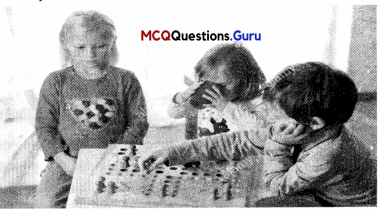Relations and Functions Class 12 MCQs Questions with Answers
Relation And Function Class 12 MCQ Chapter 1 Question 1.
Let T be the set of all triangles in the Euclidean plane, and let a relation R on T be defined as aRb if a is congruent to b V a, b ∈ T. Then R is ……………
(A) reflexive but not transitive
(B) transitive but not symmetric
(C) equivalence relation
(D) None of these
Answer:
(C) equivalence relation
Explanation:
Consider that aRb, if a is congruent to b, ∀ a, b ∈ T.
Then, aRa ⇒ a ≅ a,
Which is true for all a ∈ T
So, R is reflexive, ……(i)
Let aRb ⇒ a ≅ b
⇒b ≅ a
⇒ bRa
So, R is symmetric. ……(ii)
Let aRb and bRc
⇒b ≅ b and b ≅ a
⇒ a ≅ c ⇒ aRc
So, R is transitive …..(iii)
Hence, R is an equivalence relation.
![]()
Relations And Functions Class 12 MCQ Chapter 1 Question 2.
Consider the non-empty set consisting of children in a family and a relation R defined as aRb if a is brother of b. Then R is …………..
(A) symmetric but not transitive
(B) transitive but not symmetric
(C) neither symmetric nor transitive
(D) both symmetric and transitive
Answer:
(B) transitive but not symmetric
Explanation:
aRb ⇒ a is brother of b.
This does not mean b is also a brother of a as b can be a sister of a.
Hence, R is not symmetric.
aRb ⇒ a is brother of b
and bRc ⇒ b is a brother of c.
So, a is brother of c.
Hence, R is transitive.
MCQ On Relation And Function Class 12 Chapter 1 Question 3.
The maximum number of equivalence relations on the set A = {1,2,3} are …………
(A) 1
(B) 2
(C) 3
(D) 5
Answer:
(D) 5
Explanation:
Given that, A = (1,2,3}
Now, number of equivalence relations are as follows:
R1 = {{1,1), (2,2), (3,3)}
R2 = {‘(1,1), (2,2), (3,3), (1,2), (2,1)}
R3 = {(1,1), (2,2), (3,3), (1,3), (3,1)}
R4 = {(1,1), (2,2), (3,3), (2,3), (3,2)}
R5 = {(1,2,3) ⇔ A X A = A2}
∴ Maximum number of equivalence relations on the set A = {1,2,3} = 5
MCQ Of Relation And Function Class 12 Chapter 1 Question 4.
If a relation R on the set {1, 2, 3} be defined by R = {(1,2)}, then R is …………
(A) reflexive
(B) transitive
(C) symmetric
(D) None of these
Answer:
(B) transitive
Explanation:
R on the set {1, 2, 3} is defined by R = {(1,2)}
It is clear that R is transitive.
![]()
Class 12 Maths Chapter 1 MCQ Questions Question 5.
Let us define a relation R in R as aRb if a≥b. Then R is ………..
(A) an equivalence relation
(B) reflexive, transitive but not symmetric
(C) symmetric, transitive but not reflexive
(D) neither transitive nor reflexive but symmetric.
Answer:
(B) reflexive, transitive but not symmetric
Explanation:
Given that, aRb if a≥b
⇒ aRa ⇒ a≥a which is true
Let aRb, a≥b, then b≥a which is not true as R is not symmetric.
But aRb and bRc
⇒ a≥b and b≥b
⇒ a≥c
Hence, R is transitive.
Relation And Function MCQ Maths Chapter 1 Question 6.
Let A = {1,2,3} and consider the relation R = (1,1), (2,2) , (3, 3), (1,2), (2, 3), (1,3)}. Then R is …………
(A) reflexive but not symmetric
(B) reflexive but not transitive
(C) symmetric and transitive
(D) neither symmetric, nor transitive
Answer:
(A) reflexive but not symmetric
Explanation:
Given that A = {1,2,3}
and R = (1,1), (2,2), (3,3), (1,2), (2,3), (1,3)}.
∴(1,1), (2,2), (3,3) ∈ R
Hence, R is reflexive.
(1,2) e R but (2,1) & R
Hence, R is not symmetric.
(1,2) ∈ R and (2,3) ∈ R
⇒ (1,3) ∈ R
Hence, R is transitive.
Relation And Function Class 12 MCQ Questions Question 7.
Let R be the relation in the set {1, 2, 3, 4} given by R = {(1, 2), (2, 2), (1, 1), (4, 4), (1, 3), (3, 3), (3, 2)}.
Choose the correct
Answer:
(A) R is reflexive and symmetric but not transitive
(B) R is reflexive and transitive but not symmetric
(C) R is symmetric and transitive but not reflexive
(D) R is an equivalence relation
Answer:
(B) R is reflexive and transitive but not symmetric
Explanation:
Let R be the relation in the set (1,2, 3,4} is given by:
R = {(1,2), (2,2), (1,1), (4,4), (1,3), (3, 3), (3,2)}
(a) (1,1), (2,2), (3,3), (4,4) ∈ R
Therefore, R is reflexive.
(b) (1,2) ∈ R but (2,1) ∈ R.
Therefore, R is not symmetric.
(c) If (1,3) ∈ R and (3,2) e R then (1,2) ∈ R.
Therefore, R is transitive.
![]()
Class 12 Maths Chapter 1 MCQ Question 8.
Let A = {1, 2, 3}. Then number of relations containing (1, 2) and (1, 3) which are reflexive and symmetric but not transitive is ……….
(A) 1
(B) 2
(C) 3
(D) 4
Answer:
(A) 1
Explanation:
The given set is A = (1,2,3}.
The smallest relation containing (1, 2) and (1, 3), which is reflexive and symmetric, but not transitive is given by: .
R = {(1,1), (2,2), (3,3), (1,2), (1,3), (2,1), (3,1)} This is because relation R is reflexive as (1,1), (2,2), (3,3) ∈ R.
Relation R is symmetric since (1,2), (2,1) 6 R and (1,3) , (3,1) ∈ R.
But relation R is not transitive as (3,1), (1,2) ∈ R, but (3,2) = R.
Now, if we add any two pairs (3,2) and (2,3) (or both) to relation R, then relation R will become transitive.
Hence, the total number of desired relations is one.
Relation And Function MCQ Class 12 Chapter 1 Question 9.
If the set A contains 5 elements and the set B contains 6 elements, then the number of one-one and onto mappings from A to B is …………
(A) 720
(B) 120
(C) 0
(D) None of these
Answer:
(C) 0
Explanation:
We know that, if A and B are two non-empty finite sets containing m and n elements, respectively, then the number of one- one and onto mapping from A to B is
nl if m – n
0, if m ≠ n
Given that, m = 5 and n = 6
∴m ≠ n
Number of one-one and onto mapping = 0
MCQs On Relations And Functions Class 12 Question 10.
Let A = {1, 2, 3, …n} and B = {a, b}. Then the number of surjections from A into B is ………..
(A) nP2
(B) 2n– 2
(C) 2n -1
(D) None of these
Answer:
(B) 2n– 2
Explanation:
Total number of functions from A toB = 2n
Number of into functions = 2 Number of surjections from A to B = 2n – 2
MCQ Of Maths Class 12 Chapter 1 Question 11.
Let f : R → R be defined by f(x) = \(\frac {1}{x}\) ∀x ∈R. Then f is …………..
(A) one-one
(B) onto
(C) bijective
(D) f is not defined
Answer:
(D) f is not defined
Explanation:
We have, f(x) = \(\frac {1}{x}\) ∀ x ∈ R
For x = 0,f(x) is not defined.
Hence, f(x) is a not defined function.
![]()
MCQ Relation And Function Class 12 Question 12.
Which of the following functions from Z into Z are bijections?
(A) f(x) = x3
(B) f(x) = x + 2
(C) f(x) = 2x + l
(D) f(x) = x2 + 1
Answer:
(B) f(x) = x + 2
Explanation:
For bijection on Z,f(x) must be one- one and onto.
Function f(x) = x3 + 1 is many-one as f(1) – f(-1)
Range of f(x) = x3 is not Z for x ∈ Z.
Also f(x) = 2x + 1 takes only values of type = 2k + 1 for x ∈k ∈ Z
But f(x) = x + 2 takes all integral values for x ∈ Z
Hence f(x) = x + 2 is bijection of Z.
Relations And Functions MCQ Chapter 1 Question 13.
Let f : R → R be defined as f(x) = x4. Choose the correct answer.
(A) f is one-one onto
(B) f is many-one onto
(C) f is one-one but not onto
(D) f is neither one-one nor onto
Answer:
(D) f is neither one-one nor onto
Explanation:
We know that f : R → R is defined as f(x) = x4.
Let x,y ∈ R such that f(x) = f(y)
⇒ x4 = y4
⇒ x = ±y
∴ f(x) = f(y)
does not imply that x = y.
For example, f(l) = f(-1) = 1 ,
∴ f is not one-one.
Consider an element 2 in co-domain R. It is dear that there does not exist any x in domain R such that f(x) = 2.
f is not onto.
Hence, function/is neither one-one nor onto.
Class 12 Maths Ch 1 MCQ Questions Question 14.
Let f : R → R be defined as f(x) = 3x. Choose the correct answer.
(A) f is one-one onto
(B) f is many-one onto
(C) f is one-one but not onto
(D) f is neither one-one nor onto
Answer:
(A) f is one-one onto
Explanation:
f : R →R is defined as f(x) = 3x.
Let x, y e R such that f (x) = f(y)
⇒ 3x = 3y
⇒ x = y
∴ f is one-one.
Also, for any real number y in co-domain R, there exists in R such that f\(\frac {y}{3}\)= 3\(\frac {y}{3}\) = y.
∴ f is onto.
Hence, function f is one-ohe and onto.
![]()
Assertion And Reason Based MCQs (1 Mark each)
Directions: In the following questions, A statement of Assertion (A) is followed by a statement of Reason (R). Mark the correct choice as.
(A) Both A and R are true and R is the correct explanation of A
(B) Both A and R are true but R is NOT the correct explanation of A
(C) A is true but R is false
(D) A is false and R is True
Class 12 Relation And Function MCQ Chapter 1 Question 1.
Let W be the set of words in the English dictionary. A relation R is defined on W as R = {(x, y) ∈ W x W such that x and y have at least one letter in common}.
Assertion (A): R is reflexive.
Reason (R): R is symmetric.
Answer:
(B) Both A and R are true but R is NOT the correct explanation of A
Explanation:
For any word x ∈ W
x and x have atleast one (all) letter in common
∴ (x, x) ∈ R,∀ x ∈ W R is reflexive
Symmetric: Let (x, y) e R, x, y ∈ W
⇒ x and y have adeast one letter in common
⇒ y and x have adeast one letter in common
⇒ (y, x) ∈ R
∴ R is symmetric.
Hence A is true, R is true; R is not a correct explanation for A.
Class 12 Relations And Functions MCQ Question 2.
Let R be the relation in the set of integers Z given by R = {(a, b): 2 divides a – b}.
Assertion (A): R is a reflexive relation.
Reason (R): A relation is said to be reflexive if x Rx, ∀x ∈ Z.
Answer:
(A) Both A and R are true and R is the correct explanation of A
Explanation:
By definition, a relation in Z is said to be reflexive if x R x, ∀x ∈ Z. So R is true.
a – a = 0 ⇒ 2 divides a – a ⇒ aRa.
Hence R is reflexive and A is true.
R is the correct explanation for A.
MCQ Of Chapter 1 Maths Class 12 Question 3.
Consider the setA = {1,3,5}.
Assertion (A): The number of reflexive relations on set A is 29.
Reason (R): A relation is said to be reflexive if x Rx, ∀ x ∈ Z.
Answer:
(D) A is false and R is True
Explanation:
By definition, a relation in A is said to be reflexive if x Rx, X E A. So R is true.
The number of reflexive relations on a set containing n elements is \(2^{n^{2}-n}\)
Here n = 3.
The number of reflexive relations on a set A = 29-3 = 26
Hence A is false.
![]()
MCQ On Relation And Function Maths Question 4.
Consider the function f: R → R defined as f(x) = x3
Assertion (A): f(x) is a one-one function.
Reason (R): f(x) is a one-one function if co-domain = range.
Answer:
(C) A is true but R is false
Explanation:
f(x) is a one-one function if
f(x1) = f(x2) ⇒ x1 = x2
Hence R is false.
Let f(x1) = (x2) for some x1, x2 ∈ R
⇒ (x1)3 = (x2)3
⇒ x1 = x2
Hence f(x) is one-one.
Hence A is true.
MCQ Class 12 Maths Chapter 1 Question 5.
A = {1,2,3}, B = {4,5,6,7} and f = {(l,4)(2,5) (3,6)} is a function from A to B.
Assertion (A): f(x) is a one-one function.
Reason (R): f(x) is an onto function.
Answer:
(C) A is true but R is false
Given, A= (1,2,3), B = {4, 5,6,7) and f: A → B
is defined as f = {(1, 4), (2,5), (3, 6)} i.e.,f(1) = 4
f(2) = 5 and f(3) = 6.
It can be seen that the images of distinct elements of A underf are distinct. So,f is one-one.
So, A is true.
Range of f = {4,5,6}.
Co-domain = {4,5,6,7}.
Since co-domain ≠ range, f(x) is not an onto function. Hence R is false.
Relations And Functions Class 12 MCQs Question 6.
Consider the function f: R →R defined as f(x) = \(\frac{x}{x^{2}+1}\)
Assertion (A): f(x) is not one-one.
Reason (R): f(x) is not onto.
Answer:
(B) Both A and R are true but R is NOT the correct explanation of A
Explanation:
Given, f : R → R;
f(x) = \(\frac{x}{1+x^{2}}\)
Taking x1 = 4, x2 = \(\frac {1}{4}\) ∈ R
f(x1) = f(4) = \(\frac {4}{17}\)
f(x2) = f(4) = \(\frac {4}{17}\) (x1 ≠ x2)
f(x2) = f(4) = \(\frac {4}{17}\) (x1 ≠ x2)
Í(x) = f
∴ f is not one-one.
A is true.
Let y ∈ R (co-domain)
f(x) = y
⇒ \(\frac{x}{1+x^{2}}\) = y
⇒ y(1 + x2) = x
yx2 + y – x = 0
⇒ x = \(\frac{1 \pm \sqrt{1-4 y^{2}}}{2 y}\)
since, x ∈ R,
∴ 1 – 4x2≥0
⇒ – \(\frac {1}{2}\) ≤ y ≤ \(\frac {1}{2}\)
So Range (f) ∈\(\left[-\frac{1}{2}, \frac{1}{2}\right]\)
Range (f) ≠ R (Co-domain)
∴ f is not onto.
R is true.
R is not the correct explanation for A.
![]()
Case-Based MCQs
Attempt any four sub-parts from each question.
Each sub-part carries 1 mark.
I. Read the following text and answer the following questions on the basis of the same: A general election of Lok Sabha ¡s a gigantic exercise. About 911 million people were eligible to vote and voter turnout was about 67%, the highest ever Let be the set of all citizens of India who were eligibLe to exercise their voting right in general election held in 2019. A reLation ‘R’ is defined on as follows:
ONE – NATION ONE – ELECTION FESTIVAL OF DEMOCRACY GENERAL ELECTION – 2019

R = {(V1, V2,) : V1 V2 e land both use their voting right in general election – 2019}
Class 12 Maths MCQ Chapter 1 Question 1.
Two neighbours X and Y ∈ I.X exercised his voting right while Y did not cast her vote in general election – 2019. Which of the following is true?
(A) (X,Y) ∈ R
(B) (Y, X) ∈ R
(C) (X, X) \(\notin\)R
(D) (X,Y) \(\notin\) K
Answer:
(D) (X,Y) = K
Explanation:
(X, Y) = R.
∴ X exercised his voting right while, Y did not cast her vote in general election-2019 And R = {(V1, V2) : V1V2 ∈ I and both use their voting right in general election-2019}
Question 2.
Mr. ‘X’ and his wife ‘W both exercised their voting right in general election -2019, Which of the following is true?
(A) both (X, W) and (W, X) ∈ R
(B) (X, W)e R but (W, X) ∉ R
(C) both (X, W) and (W, X) ∉ R
(D) (W, X) s R but (X, W) ∉ R
Answer:
(A) both (X, W) and (W, X) ∈ R
![]()
Question 3.
Three friends F1, F2 and F3 exercised their voting right in general election-2019, then which of the following is true?
(A) (F1, F2) ∈ R, (F2, F3) ∈ R and (F1, F3) ∈ R
(B) (F1, F2) ∈ R, (F2, F3) ∈ R and (F1, F3) ∉ R
(C) (F1, F2) ∈ R, (F2, F2) ∈ R and (F3, F3) ∉ R
(D) (F1, F2) ∉ R, (F2, F3) ∉ R and (F1, F3) ∉ R
Answer:
Option (A) is correct.
Question 4.
The above defined relation R is …………
(A) Symmetric and transitive but not reflexive
(B) Universal relation
(C) Equivalence relation
(D) Reflexive but not symmetric and transitive
Answer:
(C) Equivalence relation
Explanation:
R is reflexive, since every person is friend or itself.
i.e., (F1, F2) ∈ R
Further, (F1, F2 ) ∈ R
⇒ F1 is friend of F2
⇒ F2 is friend of F1
⇒ (F2,F1) ∈ R
⇒ R is symmetric
Moreover, (F1 F2), (F2, F3)∈ R
⇒ F1 is friend of F2 and F2 is friend of F3.
⇒ F1 is a friend of F3.
⇒ (F1, F3) ∈ R
Therefore, R is an equivalence relation.
Question 5.
Mr. Shyam exercised his voting right in General Election – 2019, then Mr. Shyam is related to which of the following?
(A) All those eligible voters who cast their votes
(B) Family members of Mr. Shyam
(C) All citizens of India
(D) Eligible voters of India
Answer:
(A) All those eligible voters who cast their votes
![]()
II. Read the following text and answer the following questions on the basis of the same:
Sherlin and Danju are playing Ludo at home during Covid-19. While rolling the dice, Sherlin’s sister Raji observed and noted the possible outcomes of the throw every time belongs to set {1, 2, 3, 4, 5, 6}. Let A be the set of players while B be the set of all possible outcomes.

A = {S, D}, B = {1, 2, 3, 4, 5, 6}
Question 1.
Let R : B → B be defined by R = {(x, y) : y is divisible by x} is
(A) Reflexive and transitive but not symmetric
(B) Reflexive and symmetric but not transitive
(C) Not reflexive but symmetric and transitive
(D) Equivalence
Answer:
(A) Reflexive and transitive but not symmetric
Explanation:
R is reflexive, since every element of B i.e.,
B = {1,2,3,4,5, 6} is divisible by itself. i.e., (1, 1), (2,2), (3,3), (4,4), (5,5), (6,6) ∈ R
further, (1, 2) ∈ R
but (2,1) ∈ R
Moreover,
(1,2), (2,4) ∈ R
⇒(1,4) ∈ R
⇒R is transitive.
Therefore, R is reflexive and transitive but not symmetric.
Question 2.
Raji wants to know the number of functions from A to B. How many number of functions are possible?
(A) 62
(B) 26
(C) 6!
(D) 212
Answer:
(A) 62
Question 3.
Let R be a relation on B defined by R = {(1,2), (2,2), (1,3) , (3,4), (3,1), (4, 3), (5,5)}. Then R is
(A) Symmetric
(B) Reflexive
(C) Transitive
(D) None of these
Answer:
(D) None of these
Explanation:
R = {(1,2), (2,2), (1,3), (3,4), (3,1), (4,3) , (5,5)} R is not reflexive.
Since, (1,1), (3, 3), (4,4), (6,6) e R
R is not symmetric.
Because, for (1,2) ∈ R there does not exist (2,1) ∈ R.
R is not transitive.
Because for all element of B there does not exist,
(a, b) (b, c) ∈ R and (a, c) ∈ R.
![]()
Question 4.
Raji wants to know the number of relations possible from A to B. How many numbers of relations are possible?
(A) 62
(B) 26
(C) 6!
(D) 212
Answer:
(D) 212
Question 5.
Let R : B →B be defined by R = {(1,1), (1, 2), (2, 2), (3, 3), (4, 4), (5,5), (6,6)}, then R is
(A) Symmetric
(B) Reflexive and Transitive
(C) Transitive and symmetric
(D) Equivalence
Answer:
(B) Reflexive and Transitive
III. Read the following text and answer the following questions on the basis of the same:
An organization conducted bike race under 2 different categories-boys and girls. Totally there were 250 participants. Among all of them finally three from Category 1 and two from Category 2 were selected for the final race. Ravi forms two sets B and G with these participants for his college project. Let B = {b1 b2, b3} G = {g1 , g2} where B represents the set of boys selected and G the set of girls who were selected for the final race. Ravi decides to explore these sets for various types of relations and functions

Question 1.
Ravi wishes to form all the relations possible from B to G. How many such relations are possible?
(A) 26
(B) 25
(C) 0
(D) 23
Answer:
(A) 26
Question 2.
Let R : B → B be defined by R = {(x, y) : x and y are students of same sex}, Then this relation R is
(A) Equivalence
(B) Reflexive only
(C) Reflexive and symmetric but not transitive
(D) Reflexive and transitive but not symmetric
Answer:
(A) Equivalence
Explanation:
R : B → B be defined by R = {(x, y) : x and y are students of same sex}
R is reflexive, since, (x, x) ∈ R
R is symmetric, since, (x, y) ∈ R and (y, x) ∈ R
R is transitive. For a,b,c ∈ B
(a, b) (b, c) ∈ R
and (a, c) ∈ R.
Therefore R is equivalence relation.
![]()
Question 3.
Ravi wants to know among those relations, how many functions can be formed from B to G?
(A) 22
(B) 212
(C) 32
(D) 23
Answer:
(D) 23
Question 4.
Let R : B → G be defined by R = {(b1 g1), (b2, g2), (b3 g1}, then R is ………..
(A) Injective
(B) Surjective
(C) Neither Surjective nor Injective
(D) Surjective and Injective
Answer:
(B) Surjective
Explanation:
R : B → G be defined by R = {(b1 g1), (b2, g2), (b3 g1)}
R is surjective, since, every element of G is the image of some element of B under R, i.e., For g1 g2 ∈ G,
there exists an elements b1 b2, b3 ∈ B,
(b1 g1), (b2, g2), (b3 g1) ∈ R-
Question 5.
Ravi wants to find the number of injective functions from B to G. How many numbers of injective functions are possible?
(A) 0
(B) 2!
(C) 3!
(D) 0!
Answer:
(A) 0
IV. Read the following text and answer the following questions on the basis of the same:
Students of Grade 9, planned to plant saplings along straight lines, parallel to each other to one side of the playground ensuring that they had enough play area. Let us assume that they planted one of the rows of the saplings along the line y = x – 4. Let L be the set of all lines which are parallel on the ground and R be a relation on L.

Question 1.
Let relation R be defined by R = {(L1, L2): L1 || L2 where L1, L2 ∈ L} then R is …………. relation
(A) Equivalence
(B) Only reflexive
(C) Not reflexive
(D) Symmetric but not transitive
Answer:
(A) Equivalence
Explanation:
Let relation R be defined by
R = {(L1, L2): L1 || L2 where L1, L2 ∈ L}.
R is reflexive, since every line is parallel to itself. Further, (L1 L2) ∈ R
⇒ L1 is parallel to L2
⇒ L2 is parallel to L1
⇒ (L2, L1) ∈R
Hence, R is symmetric.
Moreover, (L1L2), (L1, L3) ∈R
⇒ L1 is parallel to L2 and L2 is parallel to L3
⇒ L1is parallel to L3
⇒ (L1, L3) ∈ R
Therefore, R is an equivalence relation
![]()
Question 2.
Let R = {(L1, L2): L1 ⊥ L2 where L1, L2 ∈ L} which of the following is true?
(A) R is Symmetric but neither reflexive nor transitive
(B) R is Reflexive and transitive but not symmetric
(C) R is Reflexive but neither symmetric nor transitive
(D) R is an Equivalence relation
Answer:
(A) R is Symmetric but neither reflexive nor transitive
Explanation:
R is not reflexive, as a line L1, can not be perpendicular to itself, i.e., (L1, L1,) ☐ R.
R is symmetric as (L1, L2) ∈ R
As, L1 is perpendicular to L2 and L2 is perpendicular to L1 (L2, L1) ∈ R
R is not transitive. Indeed, it L1 is perpendicular to L2 and L2 is perpendicular to L3 then L1 can never be perpendicular to L3.
In fact L1 is parallel to L3
i.e., (L1, L2) ∈ R, (L2, L3) ∈ R but (L1, L3) ∈ R
i.e., symmetric but neither reflexive nor transitive.
Question 3.
The function f : R → R defined by f(x) = x – 4 is ……………
(A) Bijective
(B) Surjective but not injective
(C) Injective but not Surjective
(D) Neither Surjective nor Injective
Answer:
(A) Bijective
Explanation:
The function/is one-one,
for f(x1) = f(x2)
Also, given any real number y in R, there exists y + 4 in R
Such that f(y + 4) = y + 4 – 4 = y Hence,/is onto
Hence, function is both one-one and onto, i.e., bijective.
Question 4.
Let f : R → R be defined by f(x) = x – 4. Then the range of f(x) is …………..
(A) R
(B) Z
(C) W
(D) Q
Answer:
(A) R
Explanation:
Range of f (x) is R
![]()
Question 5.
Let R = {(L1, L2 : L1 || L2 and L1 : y = x – 4} then which of the following can be taken as L2?
(A) 2x – 2y + 5 = 0
(B) 2x + y = 5
(C) 2x + 2y + 7 = 0
(D) x + y = 7
Answer:
(A) 2x – 2y + 5 = 0
Explanation:
Since, L1 || L2
then slope of both the lines should be same.
Slope of L1 = 1
⇒ Slope of L2 = 1
And 2x – 2y + 5 = 0
-2y = -2x – 5
y = x + \(\frac {5}{2}\)
Slope of 2x – 2y + 5 = 0 is 1
So, 2x – 2y + 5 = 0 can be taken as L2
V. Read the following text and answer the following questions n the basis of the same:
Raji visited the Exhibition along with her family. The Exhibition had a huge swing, which attracted many children. Raji found that the swing traced the path of a Parabola as given by y = x2.

Question 1.
Let f: R → R be defined by f(x) = x2 is …………
(A) Neither Surjective nor Injective
(B) Surjective
(C) Injective
(D) Bijective
Answer:
(A) Neither Surjective nor Injective
Explanation:
f : R →R be defined by f(x) = x2
∵ f(-1) = f(1) = 1,
but -1 ≠ 1
f is not injective
Now, -2 ∈ R. But, there does not exist any element x ∈ R such that f(x) = -2 or x2 = -2
∴ f is not surjective.
Hence, function f is neither injective nor surjective.
![]()
Question 2.
Let f : N → N be defined by f(x) = x2 is
(A) Surjective but not Injective
(B) Surjective
(C) Injective
(D) Bijective
Answer:
(C) Injective
Explanation:
f: N -4 N be defined by f(x) = x2 for x, y ∈ N,f(x) = f(y)
⇒ x2 = y2
⇒ x = y
∴ f is injective
Now; 2 ∈ N,
But, there does not exist any x in n such that f(x) = x2 = 2
∴ f is not surjective
Hence, function is injective but not surjective.
Question 3.
Let f: (1, 2, 3, ….} → (1, 4, 9, ….} be defined by f(x) = x2 is ………….
(A) Bijective
(B) Surjective but not Injective
(C) Injective but Surjective
(D) Neither Surjective nor Injective
Answer:
(A) Bijective
Explanation:
f : {I, 2, 3,….} → {1,4, 9,…} be defined by f(x) = x2
x1 ∈ {I, 2, 3,…} and x2 ∈{1,2,9,….}
f(x1) = f(x2)
⇒ x12 = x22
⇒ x1 = x2
∴ f is injective
Now, 4 € {1, 4, 9…}, there exist 2 in {1, 2, 3 …} such that f(x) = 22 = 4, Hence, f is surjective Therefore f is bijective.
Question 4.
Let : N → R be defined by f (x) = x2. Range of the function among the following is ……………
(A) {1,4,9,16,…}
(B) {1,4,8,9,10,…}
(C) {1,4,9,15,16,…}
(D) {1,4,8,16,…}
Answer:
(A) {1,4,9,16,…}
Explanation:
Range of f = {1,4,9,16,…} ∵N = {1,2,3 }
![]()
Question 5.
The function f: Z → Z defined by f(x) = x2 is …………..
(A) Neither Injective nor Surjective
(B) Injective
(C) Surjective
(D) Bijective
Answer:
(A) Neither Injective nor Surjective
Explanation:
f : z → z defined by f(x) = x2
So, f(-1) = f(1), but 1 ≠ -1
∴ f is not injective
Now, -2 ∈ Z, but, there docs not exist any element x ∈ z such that
f(x) = -2
or x2 = -2
∴ f is not surjective
Hence ,f is neither injective nor surjective.